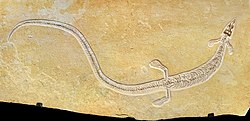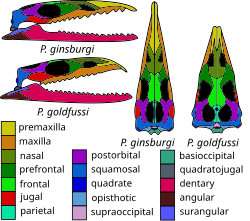Pleurosaurus (from Greek: πλευρᾱ́ pleurā́, 'rib' or 'side' and Greek: σαῦρος saûros, 'lizard') is an extinct genus of aquatic reptiles belonging to the order Rhynchocephalia. Pleurosaurus fossils have primarily been discovered in the Solnhofen Limestone of Bavaria, Germany and the Canjuers lagerstatte near Canjuers, France, both dating to the Late Jurassic. It contains two species, P. goldfussi and P. ginsburgi.[1]
| Pleurosaurus Temporal range: Late Jurassic,
| |
|---|---|

| |
| P. sp., National Taiwan Museum | |

| |
| Skull diagram | |
| Scientific classification | |
| Domain: | Eukaryota |
| Kingdom: | Animalia |
| Phylum: | Chordata |
| Class: | Reptilia |
| Order: | Rhynchocephalia |
| Family: | †Pleurosauridae |
| Genus: | †Pleurosaurus Meyer, 1831 |
| Type species | |
| †Pleurosaurus goldfussi Meyer, 1831
| |
| Species | |
| |
History of discovery
editPleurosaurus was first described from the Solnhofen Limestone by Christian Erich Hermann von Meyer in 1834, based on the species Pleurosaurus goldfussi. In 1970 fossils were reported from the lithographic limestones in a quarry near the village of Aiguines in the Canjuers plateau, France. In 1974, Pleurosaurus ginsburgi was described based on MNHN 1983-4-CNJ 67, a mostly complete skeleton found at the Aiguines quarry.[1] Pleurosaurus is one of two unambiguous members of the family Pleurosauridae, alongside Palaeopleurosaurus from the Early Jurassic of Germany.[1] In 2012, fragmentary remains likely belonging to P. goldfussi were reported from central Poland.[2]
Description
editPleurosaurus is one of the few known aquatic sphenodontians. It reached a maximum body length of 1.5 metres (4.9 ft).[3] The body and especially the tail were elongated, while the limbs were comparatively short. The elongated triangular skull was highly modified from those present in other rhynchocephalians. Pleurosaurus swam via undulating its tail from side to side (anguilliform locomotion), while it probably used its limbs to steer. It lived in shallow marine environments, and was probably piscivorous.[4] Pleurosaurus goldfussi and Pleurosaurus ginsburgi are distinguished by differing skull proportions, different numbers of presacral vertebrae (50 in P. goldfussi vs 57 in P. ginsburgi), and considerably shorter forelimbs on P. ginsburgi.[1]
-
P. goldfussi
-
P. goldfussi
-
P. ginsburgi
References
edit- ^ a b c d Dupret, V. (2004). The pleurosaurs: anatomy and phylogeny. Revue de Paléobiologie, 9: 61-80.[1]
- ^ Kin, Adrian; Gruszczyński, Michał; Martill, David; Marshall, Jim D.; Błażejowski, Błażej (January 2013). "Palaeoenvironment and taphonomy of a Late Jurassic (Late Tithonian) Lagerstätte from central Poland". Lethaia. 46 (1): 71–81. Bibcode:2013Letha..46...71K. doi:10.1111/j.1502-3931.2012.00322.x. ISSN 0024-1164.
- ^ Michael Benton, Vertebrate Paleontology 2009 p. 455 (3rd Edition)
- ^ Klein, Nicole; Scheyer, Torsten M. (February 2017). "Microanatomy and life history in Palaeopleurosaurus (Rhynchocephalia: Pleurosauridae) from the Early Jurassic of Germany". The Science of Nature. 104 (1–2): 4. Bibcode:2017SciNa.104....4K. doi:10.1007/s00114-016-1427-3. ISSN 0028-1042. PMID 28005148. S2CID 27133670.